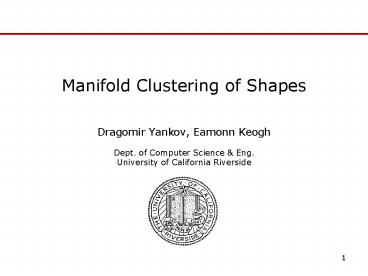Manifold Clustering of Shapes - PowerPoint PPT Presentation
Title:
Manifold Clustering of Shapes
Description:
Manifold Clustering of Shapes Dragomir Yankov, Eamonn Keogh Dept. of Computer Science & Eng. University of California Riverside Outline Problem formulation Shape ... – PowerPoint PPT presentation
Number of Views:72
Avg rating:3.0/5.0
Title: Manifold Clustering of Shapes
1
Manifold Clustering of Shapes
- Dragomir Yankov, Eamonn Keogh
- Dept. of Computer Science Eng.
- University of California Riverside
2
Outline
- Problem formulation
- Shape space representation. Similarity metric.
- Manifold clustering of shapes
- Handling noisy and bridged clusters
- Experimental evaluation
3
Problem formulation
- Object recognition systems dependent heavily on
the accurate identification of shapes - Learning the shapes without supervision is
essential when large image collections are
available
- In this work we propose a robust approach for
clustering of 2D shapes
The malaria images are part of the Hoslink
medical databank, and the diatoms images are part
of the collection used in the ADIAC project.
4
Data representation
- Requirements
- invariant to basic geometric transformations
- handle limited rotations
- low dimensionality for meaningful clustering
- Centroid-based time series representation
- All extracted time series are further
standardised and resampled to the same length
5
Measuring shape similarity
- The Euclidean distance does not capture the real
similarities - Rotationally invariant distance rd
- approximate rotations as
- and define
- Metric properties of rd
6
Manifold clustering of shapes
- Vision data often reside on a nonlinear embedding
that linear projections fail to reconstruct - We apply Isomap to detect the intrinsic
dimensionality of the shapes data.
- Isomap moves further apart different clusters,
preserving their convexity
7
Handling noisy and bridged clusters
- Instability of the Isomap projection
- The degree-k-bounded minimum spanning tree
(k-MST) problem - The b-Isomap algorithm
8
Experimental evaluation
- Diatom dataset
- 4classes
- 2 classes (Stauroneis
- and Flagilaria)
Dataset Method Dim k Acc() Std()
4-class diatoms MDS 3D N/A 62.3 5.2
4-class diatoms Isomap 3D 16 86.2 3.0
4-class diatoms b-Isomap 3D 4 83.0 3.6
2-class diatoms MDS 3D N/A 90.2 1.3
2-class diatoms Isomap 3D 5 92.7 1.3
2-class diatoms b-Isomap 3D 3 98.3 0.9
9
Experimental evaluation
- Marine creatures
Data Method Dim k Acc
Marine creatures MDS 2D N/A 61.0
Marine creatures Isomap 3D 4 77.6
Marine creatures b-Isomap 3D 4 80.0
- Arrowheads
Data Method Dim k Acc
Arrow heads MDS 3D N/A 75.6
Arrow heads Isomap 3D 14 85.2
Arrow heads b-Isomap 2D 6 85.1
10
Conclusions and future work
- We presented a method for clustering of shapes
data invariantly to basic geometric
transformations - We demonstrated that the Isomap projection built
on top of a rotationally invariant distance
metric can reconstruct correctly the intrinsic
nonlinear embedding in which the shape examples
reside. - The degree-bounded MST modification of the Isomap
algorithm can decreases the effect of bridging
elements and noise in the data. - Our future efforts are targeted towards an
automatic adaptive approach for combining the
features of Isomap and b-Isomap
Thank you!































